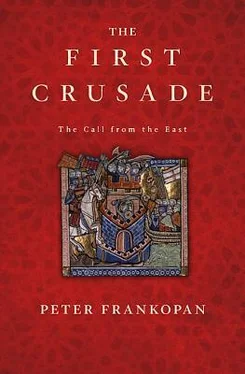It may be that the prospect of Alexios joining the expedition spurred the decision to move on Jerusalem in order to strengthen their position, for at the start of May 1099, the Crusaders abandoned the siege of Arqa and marched at full speed on Jerusalem. After eighteen months, during which the scope, aims and nature of the expedition had changed out of all recognition, the purpose of the Crusade suddenly returned.
After all they had been through – disease and deprivation at Antioch, countless casualties sustained in combat and along the long march, and conditions so bad that the battle-hardened had turned to cannibalism – it was not surprising that the arrival of the Crusader force at Jerusalem on 7 June 1099 was accompanied by rejoicing and exultation. One chronicler wrote of tears of happiness flowing when the army reached its destination. 1
Yet there was still much to be done. Jerusalem was heavily fortified, with impressive walls and defences and a garrison that had been preparing for months for the arrival of the western knights. As the Crusaders met in council and pondered how to storm the city, Tancred, suffering from an acute case of dysentery, made for a nearby cave; there he found a pile of equipment for building siege engines, remnants of past attempts to take the city. It was another moment of great good fortune for the Crusaders. 2Useful materials were gathered locally before news was received that six Genoese boats had put in at Jaffa, carrying supplies and provisions, as well as ropes, hammers, nails, axes and hatchets. 3Even though bringing the materials back to camp involved a fifty-mile round trip across hostile terrain, this was a godsend that made the difference between success and failure of the entire expedition. 4
In spite of the many successes and the fearsome reputation which preceded the western knights, Jerusalem’s garrison had good reason to think that they could repel the attacks. Like Antioch, the city enjoyed the protection of formidable defences. Moreover, while it was still substantial, the attacking army had decreased dramatically in size over the course of the previous two years, losing men in battle as well as to illness and disease. It has been estimated that by the time it reached Jerusalem, the western army had been reduced to a third of its original strength. 5The inhabitants of the Holy City could also take heart from the difficult conditions the Crusaders were experiencing in front of the city walls. This time the primary problem was not food. As Fulcher of Chartres reported: ‘Our men did not suffer from lack of bread or meat. Yet because the area was dry, unwatered and without streams, our men as well as our beasts suffered for lack of water to drink.’ 6
All the wells outside Jerusalem had been blocked up or poisoned in anticipation of the imminent assault, with the result that a round trip of twelve miles was needed to fetch fresh water from the nearest source. Ox and buffalo hides were stitched together to try to transport it safely and in large volume. Those brave enough to go and find water ran the risk of ambush. And when they returned to camp, the returning water-bearers often met with furious argument, so acute was the thirst, so strong the heat. Some saw the chance to make money from such ventures, feeling they deserved more than the thanks and appreciation of their comrades, and insisted on payment for water. As a result, water was not shared out equally but sold at prices that were nothing short of extortionate. For those able or willing to pay, it was not always good value for money: at times the water was dark and muddy, and on occasion even contained leeches. Filthy water led to disease; eyewitnesses described how drinking unclean water caused severe swelling of the throat and stomach, and often led to an agonising death. 7
There were few alternatives for those who could not afford to buy from their unscrupulous peers. One was the Pool of Siloam, just outside the walls of Jerusalem; fed by a natural spring and safe to drink, water could be found there at least some of the time. But getting to the pool was another matter: as it was located close to the city’s battlements, a well-judged shot from the walls could prove lethal. 8There was also the risk of ambush; some Crusaders who ventured there were attacked and killed, while others were captured never to be heard of again. 9
The inhabitants of Jerusalem were also reassured by messages they received from the powerful vizier of Cairo, al-Afdal, telling them that he was coming to their rescue and was a mere fifteen days away. The capture of one of his messengers, who revealed this information under torture, spread alarm among the Crusaders. Their concerns were heightened after the interception of a carrier pigeon brought down by a hawker. Describing the western knights as foolhardy, headstrong and disorderly, the note it was carrying urged the Muslim governors of Acre and Caeserea to attack the Crusaders, stressing that if they did so, they would find easy pickings. 10
The westerners’ response was to accelerate plans to capture the city. On 8 July 1099 they held a solemn procession with knights bearing crosses, walking barefoot round the walls of Jerusalem, imploring God for help and mercy. The inhabitants of the city used the spectacle to indulge in target practice, shooting arrows at the men marching around the city. It seemed to them that they had little to fear from the bedraggled and beleaguered western army. 11
The Crusaders were not relying on divine inspiration alone for their success, however. Two assault towers were built at speed, and as soon as they were ready, they were set up against the walls, one to the south of the city, the other close to the imposing Quadrangular Tower defending the western side of Jerusalem. The construction and positioning was watched closely by the city’s garrison, who reinforced defences and deployed resources accordingly. 12
In the searing heat of July, the Crusaders now pulled off a tactically brilliant move that brought them a decisive advantage. The siege tower that had been assembled by the Quadrangular Tower was dismantled during the night of 9 July and re-erected to the north of the city where weaker defences had been identified and the ground was flat. 13The attack on Jerusalem now began in earnest. A defensive ditch was quickly filled in and a tranche of the outer wall dismantled. Stonethrowing devices provided vital cover, as did Crusade archers, raining arrows on to the defenders. A huge battering ram was used to make a breach in the defences that was large enough for the siege tower to be brought up against the main wall. Rather than pull the ram back out of the way, and lose precious time, it was then set on fire. As the tower was hauled into position under furious enemy fire, sappers set about mining the wall from below. Others climbed up to the top of the tower, fighting the defenders manning the wall, and before long gaining a position on the battlements. 14Jerusalem was suddenly teetering.
While there was rapid progress on the defences to the north of the city, concerted efforts were being made simultaneously on a southern section of the walls. Another siege tower, well built and robust, had been pushed against the battlements. Its value, however, proved to lie less in its operational efficiency than in the fact that it drew enemy fire and distracted attention from the assault elsewhere. The defenders had concluded that they were more vulnerable to attack from the south of the city and concentrated resources there as a result: nine of the fifteen projectile devices in Jerusalem were positioned to protect the southern approach. Other contraptions that flung fireballs of fat, resin, pitch and hair into the Christian army were also concentrated in this part of the city. The defence of the southern section was successful, for the siege tower was set ablaze and substantial casualties were sustained by the westerners. The counter-attack was so well directed that the Crusaders, led by Raymond of Toulouse, contemplated withdrawal. It was only when news was received that the attack was progressing well elsewhere that efforts were renewed. As the siege engine to the south burned and missiles, oil and arrows rained on the western knights, reports came through that the Crusaders had breached the northern wall and were streaming into the city.
Читать дальше











